The sublime summer continues
Friday, August 1, 2014
July is in many respects the defining month of our gardening
year.. All our borders are heavily dependent upon herbaceous
perennials for their impact and July is the time when the greatest
number are in flower giving a real "wow factor" and delighting our
many visitors. Because of the exceptional growth since early May,
everything is at least 2 weeks earlier than normal, with dieramas
coming into flower in the first week of the month, the best show of
flowers ever on the acanthus, and daylilies at last getting over
the worst effects of the hemericallis gall midge which devastated
the flowers on the earlier flowering forms. There are so many other
examples of exceptional growth and earliness too numerous to list
but these pictures will give you some idea of the overall
effect.
The Paddock Garden borders in early July
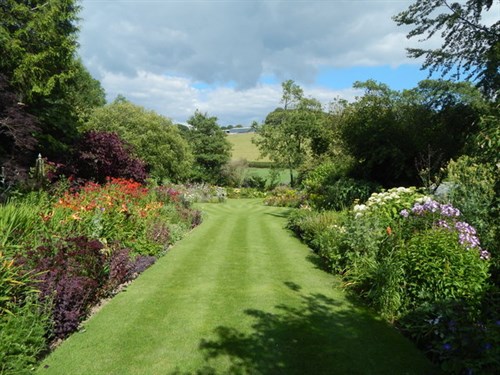
The Lodge and Picket Fence Cottage Garden
border
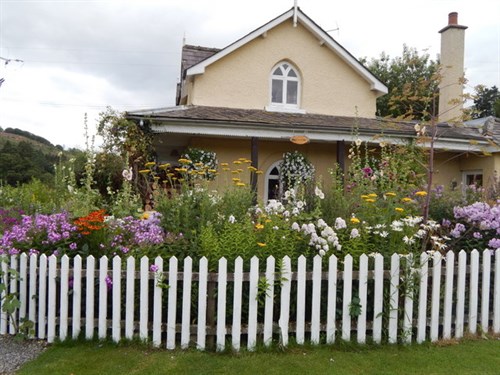
The view northwards from the Picket Fence border and and
the blue skies which were a feature of the month

The fine weather and absence of any significant rain has
required continuous daily watering, in the borders, the tunnels,
greenhouses and in the Nursery. Thanks to our friend Robert, the
"lawns guru" who kindly volunteered for watering duties, we were
able for the first time in many years to have 2 short breaks in
July to recharge the batteries, and do some garden visiting
including one very special pilgrimage which, to keep you in
suspense, I will tell you about later.
Weather
In common with rest of the UK, it was a really warm, sunny July
with just enough rain at the right time (although we would have
liked more - typical gardeners - never satisfied!). Whilst
copious watering can compensate to some extent for lack of rain,
you cannot replicate warmth day and night which summer
flowering plants respond to more than anything else and we
certainly had this throughout the month. There were only 3 days
with heavy rain, and 26 days with temperatures abov 21c,
warmest day on 26th with 27.2C but very humid. Only one night with
a minima below 10c on 9th. Light winds were another welcome feature
of the month.
Garden update
I have already sung the praises of some of the herbaceous
stars,some others are monardas, thalictrums, lilies, phlox
(showing some signs of mildew because of insufficient water at the
roots), and superb hydrangeas in a wide range of macrophylla,
serratas, paniculatas and asperas, all much earlier than usual.
An explosion of colour in the Red Border with from top
to bottom phlox "Star Fire". monarda "Garden View Scarlet",
hemerocallis "Scarlet Oak" and helenium "Sahins Early Flowerer" and
more "Garden View Scarlet" in the foreground
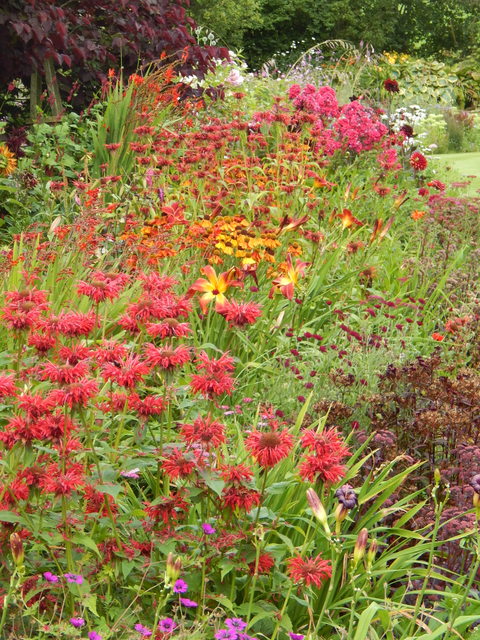
A superb tree lily "Hollywood" rivalling cardiocrinum
giganteum in size, floriferousness and scent. From humble
beginnings in four years it has reached 7 feet tall. It is set off
nicely with 2 fine phlox in the foreground

And talking of phlox what about this beauty, "Blue
Paradise" My favourite phlox is long flowering with a stunning
scent and a blue colour which is more intense at twilight. This
pic. has not been digitally enhanced.
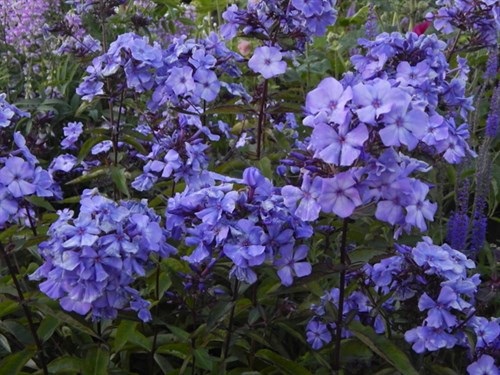
Hydrangea aspera subsp. sargentiana makes an impressive
statement in the Paddock Shade Border, 7 feet wide and tall. It is
difficult to grow well so I am really pleased by its showing this
year
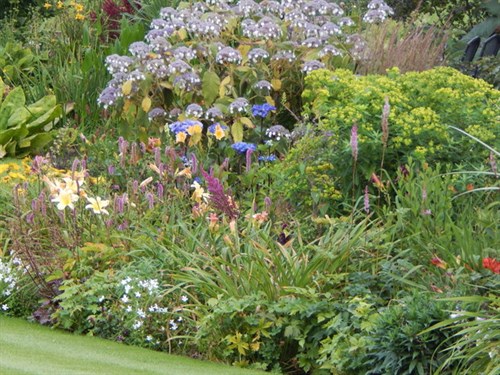
I am particularly pleased with the vegetables after a slow start
and constant visitations of rabbits. I have accounted for 17 in the
Gardens and lately there seems to be far less damage (hope that
isn't being too premature!). All of a sudden there is a good choice
coming to harvest including runner beans, French beans, huge
cabbages, fly free carrots, plenty of different salad leaves,
superb outdoor cucumbers as large as indoor varieties from a form
called Burpees. Some large bulbs of garlic were harvested yesterday
and the onions are filling out nicely. Potatoes planted out
late have nevertheless made a good size, especially Charlotte which
although classifed as a salad variety 2nd early, makes absolutely
fabulous French Fries. More on the best of the veggies under the
next heading.
The roots section of the vegetable garden filling out
nicely. Note the fleece to keep rabbits and carrot fly at
bay.
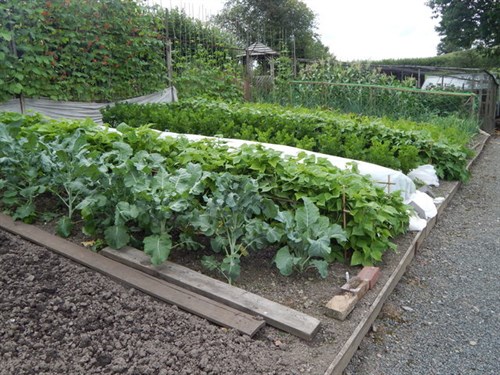
I am often seduced into thinking that July is one of the easiest
times of the year but am quickly dragged back to reality when I
reflect upon all the dead heading there is to do - with roses and
daylilies especially it is an every day time consumung task.
Weeding, lawn mowing and edging are always a priority. In our
7 metre wide borders with tightly packed planting it can be very
difficult to reach plants needing dead-heading or cutting back, and
weeding is exceptionally challenging - and by the way don't be
fooled into thinking that the closer you plant things, the less
weeds you will have although I do acknowledge it does help; however
they still have a way of establishing themseilves in the tightest
planting scheme. From whence they can soon break out to achieve
total garden domination!
Imagine getting into the middle of this section of the
Red Border to do some essential maintenance without
treading on any of the plants!

Another important July task in the borders is to refresh the
plantings to keep the colour show going towards autumn,
particularly where early flowering perennials have finished.
This is when late flowering annuals like cosmos and rudbeckias, and
half hardy perennials especially salvias come into their own. The
possibilities are endless if you use imagination and get your
timings right Grown on in decent sized pots (up to 2 litres)
during the late spring and early summer they can reach a good size
for planting out now so that they make an immediate impact lasting
until the frosts return. We were disappointed recently to find that
a few of the gardens we visited this month had not done this, for
whatever reason.
There are several other ways of adding colour including
the use of the framework of large plants like delphiniums
which have gone over, is to grow late flowering clematis or
perennial sweet pea over them. Some violas and geraniums like Ann
Folkard can scramble their way through spent perennials to fill
unsightly gaps. When all else fails, very large pots of anything
you fancy (but especially lilies) can be plunged temporarily into
the borders to raise their profile. Hard work yes and the pots will
require regular watering, but well worth the effort and if it was
good enough for Gertrude, quite good enough for the likes of you
and me!
However hard we try however there will nevertheless still be
some failures or disappointments. The cabbage white butterflies are
back with a vegance now and even though I keep my brassicas under
horticultural fleece as long as possible they still manage to find
a way in to lay their eggs. The potato blight has hit us in the
last couple of weeks, some varieties being more susceptible than
others and this year,"Blue Belle" a main crop variety which is new
to me, is completely free of blight as is the established favourite
"Cara". The haulm on all the others hase been cut off to prevent
the blight moving down the stems and infecting the tubers which
will otherwise rot in store.
Potato beds
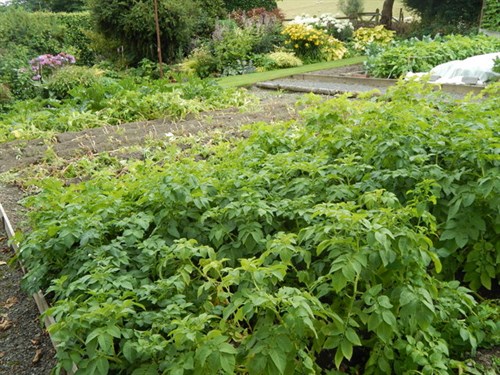
Sweet peas have been a disappointment, not helped by the fact
that most of them were pot bound before I was able to plant
them out due to the very wet ground in spring. Many of them have
stopped flowering and turned yellow. Visitors have also had similar
experiences this year which always make you feel a little
better.
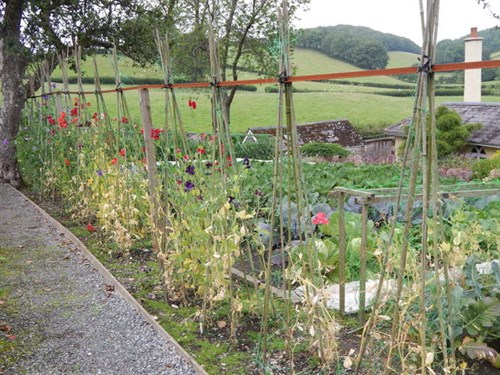
What's looking good?
Just about everything! All the various borders are shouting
"Look at Me" and individually there are some stunning plants at the
peak of perfection. To list them all would take until the August
News Item so I am doing my best to limit myself.
This section of the Paddock Shade Border is getting into
it's stride with hydrangea arborescens "Annabelle" phlox "Franz
Schubert" lilies, crocosmias and achillea "Cloth of
Gold"harmonising well.
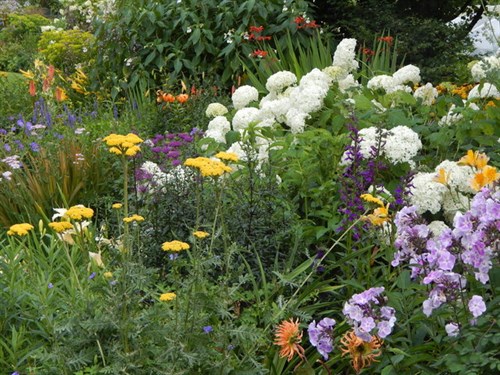
Blue is the dominant colour of this section of the of
the Picket Fence botrder with a great stand of blue hostas in full
flower in the bottom right hand side of the picture
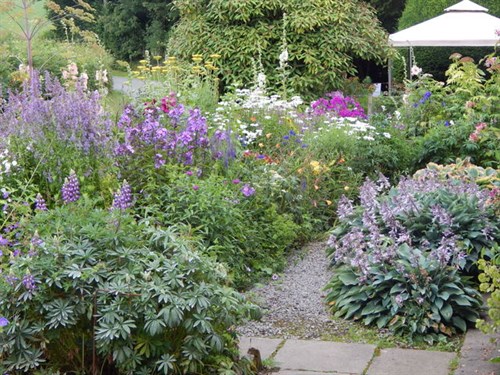
Top performers have to be the dieramas which having matured over
the last 10 years or so, have made large plants with multi stemmed
wands of great beauty in pink, purple, white;/pink and red. Some
are self sown seedlings others named clones like "Blackbird" and
"Merlin". They are easy from seed and usually flower in their
fourth year. In pots they just sit and sulk. They like very good
drainage in the winter but moisture in the summer - a difficult
horticultural balancing act which we seem to have managed very
successfully over a good number of years. They are the most perfect
tall "see through" plant making a fabulous statement at the front
of of a border. I once saw a huge stand of them at a National Trust
garden, Coleton Fishacre near Kingsweir in Devon, where they were
planted on the top of a 5 foot drystone wall alongside a path, so
that you walked under the arching wands of flowers. Brilliant,
inspirational planting.
Dieramas in all their glory.
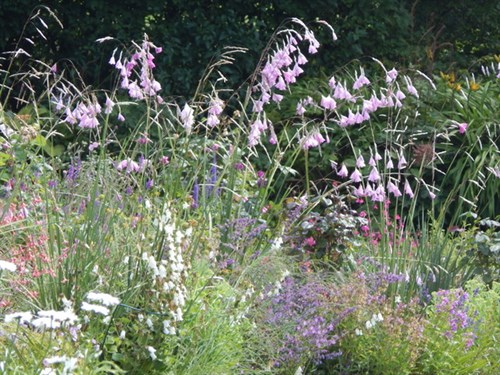
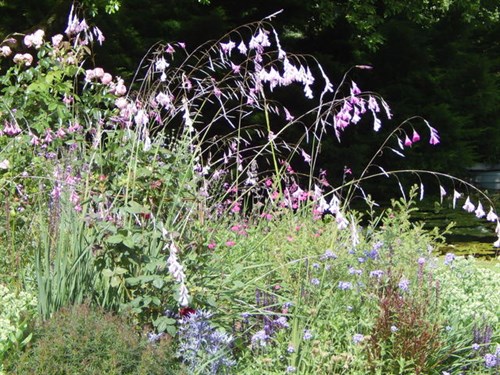
I have admired in many gardens over the years, various forms of
acanthus, an old and much celebrated plant in ancient times
commonly represented in architecture of the period (particularly
classical Greece and Italy), but they have never successfully
flowered it here. They are invasive plants over time and can
quickly fill a border if you don't vigourously thin them out - even
then they don't always flower well; but this year they have gone
absolutely nuts!! Why this should be I don't know. Was it perhaps
the very wet winter, the hot summer or a combination of the two.
Frankly my dears, I don't give a damn! They look great with
multiple flowerheads on the three plants we have in the north
facing border of the Paddock Garden. The form we grow is acanthus
spinosus; as the name suggests it has finely divided leaves with
spiky but not sharp tips. They are stately and elegant, even
classical you might say. I have also acquired two variegated forms
this year, a "Tasmanian Tiger" and a."Whitewater" which may
not be to everyones taste but make a real statement with their
multi hued green and white irregular variegation. They also have
pink and white flowers which are sensational when in bloom. The
problem is where to place them as they resent full sun, the white
scorching badly.

Regular readers will know that I like daylilies (hemerocallis)
and have about 50 varieties in the Gardens, to which I keep adding
new ones, mostly now from plants of seed of crosses made by
generous members of the American Hemerocallis Society. They
germinate readily and can make good sized flowering plants within
two years. Mostly they are interesting, occasionally spectacular
and a few are absolute nightmares! It is all part of the fun of
growing anything from seed. Fortunately the dreaded gall midge
doesn't seem to affect young plants so they all have pristine
flowers. The later flowering more mature hems. seem unaffected by
the midge so that there is at last a good show of flowers
throughout the Gardens. Here are a few of the better ones; not
perfect but entirely garden worthy.
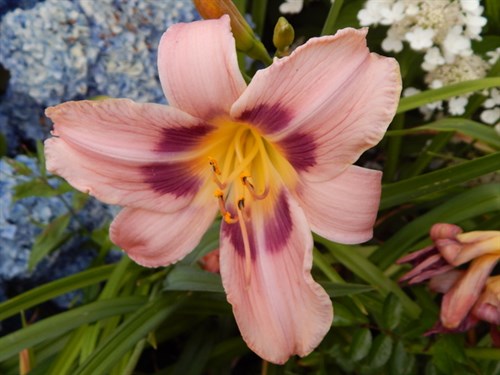
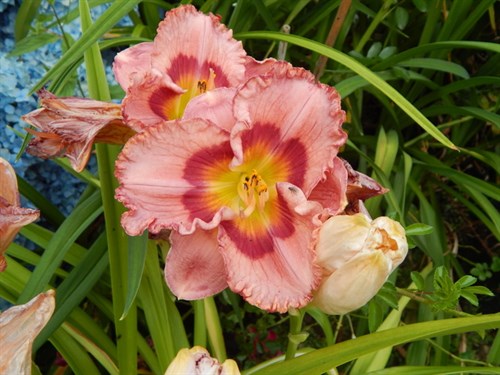
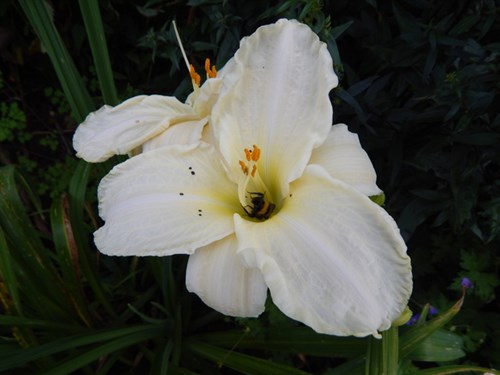


This is the one named form called, "Vespers" which I
have enjoyed for many years. Very natural looking with a strong
perfume coming most likely from one of its species parents
hemerocallis lilioasphodelus. Most yellow forms have scent
probably from the same source.

With the football World Cup in South America there were many TV
programmes and newspaper articles about life and culture in Brazil
but no-one seemed to have thought about a programme on the rare and
fabulous flora to be found there or indeed throughout the sub
continent. So here are just a couple which blow your socks off. one
from Brazil, the other from Chile.
For the second July in a row, erythtrina crista- galli,
a member of the pea family, has flowered brilliantly in the warm
sunshine. If it can do this in a polytunnel in the middle of Wales
what can it do in the steamy heat of Brazil?

And from seacliffs in Chile comes a long established
clump of the perennial lobelia tupa, revelling in the bone dry soil
at the edge of the Red Border, conditions created by the large yew
tree
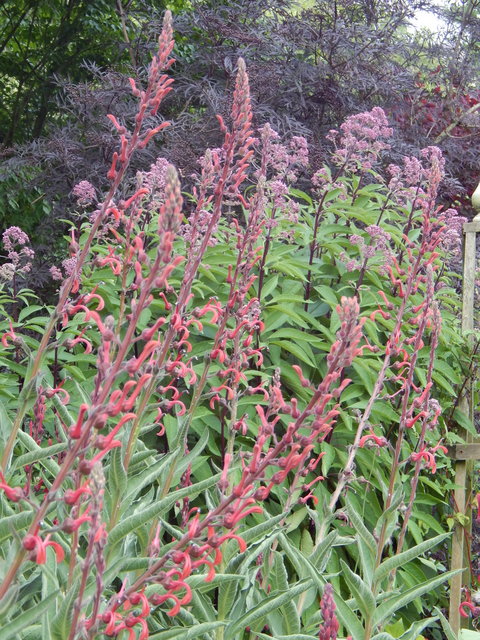
Finally in order to keep this item short (You what?!!) a gentle
plea for a couple of veggies. First peas, an easy crop if the mice
and rabbits leave them alone but an absolute disaster if they
don't. I have had one good row from five so far!
A sight I thought I would never see this year a superb
crop of pea "Hurst Green Shaft"

Celery is considered by many to be the hardest of all vegetables
to grow well and this year I think I may have cracked it. So what's
the secret? I am no expert but there are a variety of factors:
choice of variety, good strong plants from an early February sowing
under heat, protection when first planting out in late May (I use
horti fleece), copious amounts of water and some occasional
additions of balanced fertilizer like chicken pelleted manure.
Result - tender full flavoured stems with the minimum of strings
full of flavour and better than anything harvested in Spain and
sold many days later in supermarkets.
Wildlife and countryside
Fortunately not so much to report under this heading. Plenty of
insects about especially legions of blood thirsty horse flies which
give you a painful nip, particularly troublesome when mowing
the lawns. Dragon and damselflies are active aroud the Paddock Pond
but not in great quantaties yet nor many large ones either. Some
butterflies on the wing, the first this year were commas, quickly
followed by tortoiseshells, peacocks and latterly red admirals and
a few meadow browns, but so far nothing rare or unusual which is a
disappontment in such a consisitently hot summer
Also in the Paddock Pond all the tadpoles have left for pastures
new and there have been 2 separate spawnings of the rudd which is
very good news, adding to the fish stocks at no extra expense. The
waterlilies to have revelled in the hot temperatures, their huge
areas of leaf covereage substantially reducing the incidence of
blanketweed
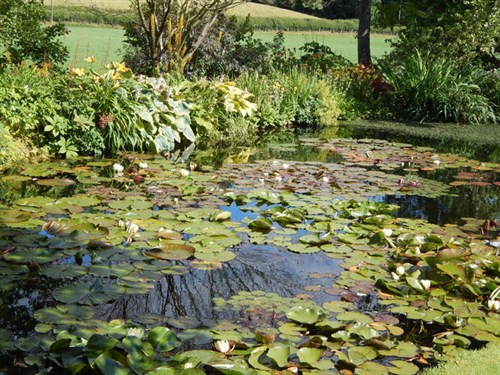
Most birds are enjoying the post fledglings period, eating all
the soft fruit in the cage (blueberries a particular favourite). It
is very pleasing to report good sightings of large numbers of
buzzards often in groups of four or more, a rare sight since the
red kites became more dominant. Even simple every day birds like
sparrows on close inspection can be interesting in their behaviour
and markings when seen close up.
A male house sparrow - sorry girls in the bird
world the men have all the best oufits (except for
me)!!
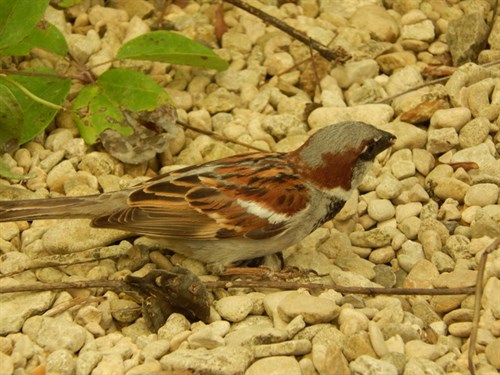
Local farmers have welcomed the fine weather to bring in the
grass harvest and some are taking a second cut, but the fields are
looking rather parched as the the topsoil is thin with underlying
rock. It is quite a contrast to Sussex and the north Cotswolds
which we recently visited where it is largely arable farming with
huge fields of ripening barley and wheat dominating the pastoral
scene and completely surrounding towns and villages of golden
limestone.
Visits and visitors
There were five group visits from a wide range of gardening
clubs and other societies, all in fine weather, and numerous visits
in smaller numbers including one visit from someone who has been
following the Gardens via our website, a first we think so many
thanks to Kelvin and it was good to meet you. To date this summer
we have raised just over £1,000 for The National Gardens Scheme
We promised ourselves a few short breaks during the month as we
are rarely ever able to get away in high summer because of the
number of visitors we receive. We went to Surrey, Sussex and the
North Cotswolds from Gloucestershire to Northamptonshire, all with
garden visits in mind, some very much better than others. The pics
below give you a flavour of some of those we visited - two were so
poor I didn't take any pictures!! Having opened our Gardens
to the public for the last 15 years we know how important it is to
make our visitors feel welcome and go the extra mile to give them
some special memories. A visit to Cilgwyn Lodge, a one acre garden,
with teas and our nursery, can often last 2 hours and it is
now the criteria by which we judge all the gardens we visit.
At last we get to Gertrude , and about time too!. You may know
who she is. If not I will explain. She is probably one of the best
garden designers who ever lived and was at her peak in the late
19th and early 20th centuries. She lived at Munstead Wood near
Godalming in Surrey for almost 40 years, in a house built for her
in the west Surrey vernacular style by Edwin Lutyens, his first
commission as an architect in his early 20's. He went on the forge
a formidable parnership with Gertrude ( surname Jekyll to rhyme
with treacle!) and they designed homes and gardens for wealthy
clients. Some are well known, from Hestercombe and Barrington Court
in Somerset to the far outpost of Holy Island off the Northumbrian
coast. All had wonderful structure and form using largely local
materials, and gardens based on Gertrude's trademark style of waves
of carefully co -ordinated colour schemes using mostly perennial
plants, where flow and harmony are the key words. Her seminal work
is a book called "Colour Schemes for the Flower Garden" and after
nearly a hundred years it is still in print, and was the source of
my inspiration for the borders at Cilgwyn Lodge. Of course there
have been many other influences too and we also have many more
plants to play with than in Gertrude's day. However some people in
horticulture wish she had never been born because of the influence
she still has on garden design, but her style and beliefs have
stood the test of time and are still greatly loved and admired.
Read her books and those written since about her, and you will
appreciate her vast plant knowledge and just how ahead of her time
she was.
By great good fortune the current owners of Munstead Wood,
in 1987 purchased the nearest house to us as a holiday home.
Sir Robert and Lady Clark became friends and we have had the
privilege of walking in Gertrude's footsteps at Munstead on several
occasions. The most recent was earlier this month when we went to
celebrate Lady Clark's 90th birhday. Even though the garden
does not have the number of gardeners it did in Gertrude's
time it is still an iconic place to visit and images from her books
can be found everywhere.
The main view of the house which sits so comfortably in
its setting

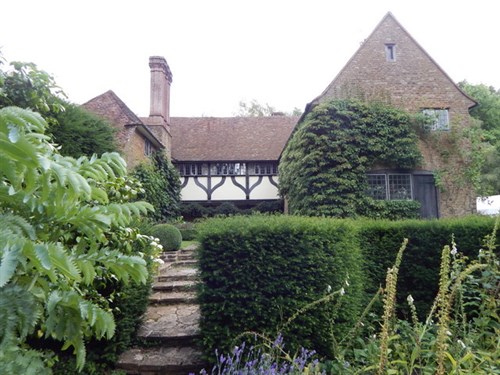
One of the most celebrated pictures of Gertrude was
taken at this entrance to the Spring Garden. The yucca on the right
(is it still the same one?) was in flower dwarfing the stooping old
lady. It is the most iconic picture of her I have ever seen.
The whole garden has images of her and her
writing.
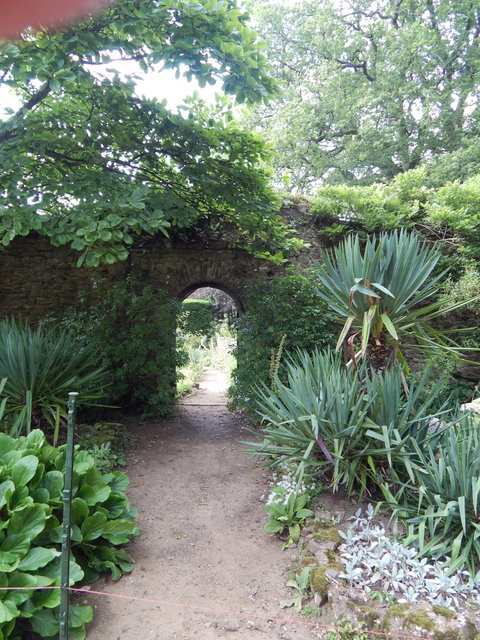
The main herbaceous borders with the benefit of a stone
wall for protection and climbers.
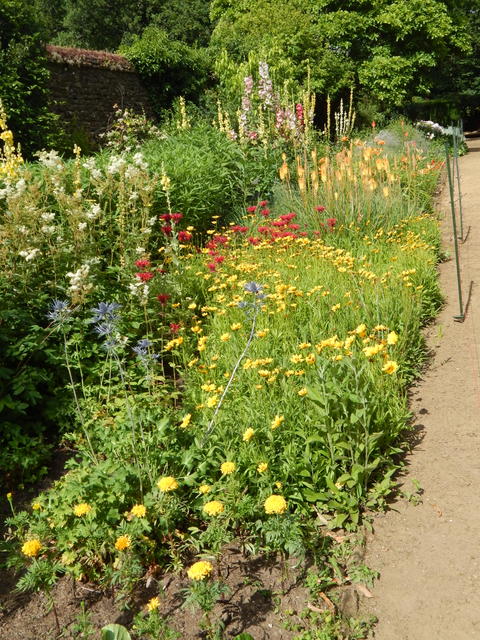
Our visits to other gardens included Sissinghurst
Castle, packed as always with tourists from all parts of the
world
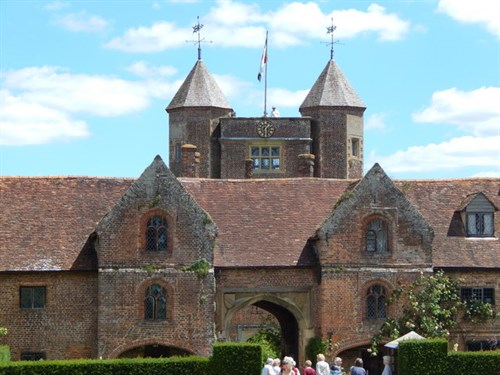
The view of the famous white garden from the top of the
tower, sadly past its peak and disappointingly with no later
plantings to fill the gaps.
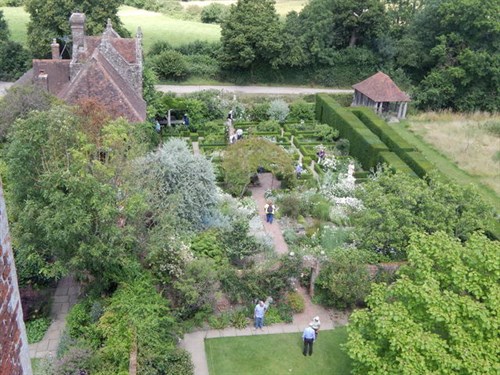
The best features in the gardens can all be found on the
many old brick walls. none better that this magnificent show of
clematis "Perle d'Azur"
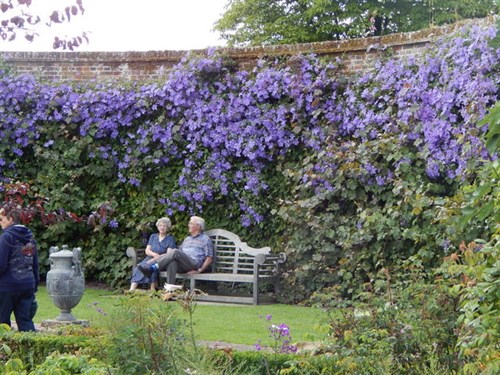
Another National Trust garden is Nymans in West Sussex,
a first visit for us and a lovely garden supremely well tended. An
island bed full of South African plants against the backdrop of the
ruins of the old house most of which was burned down in
1947
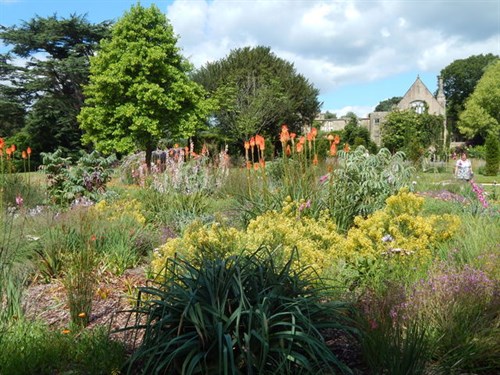
There is a small part of the bulding that still remains
with this wonderfully simple courtyard garden. Lavender on the
right and a brilliantly effective planting of deep magenta cosmos
and the umbellifer ammi visnaga, new to me but mighty impressive at
4-5 feet tall and still going strong in mid July
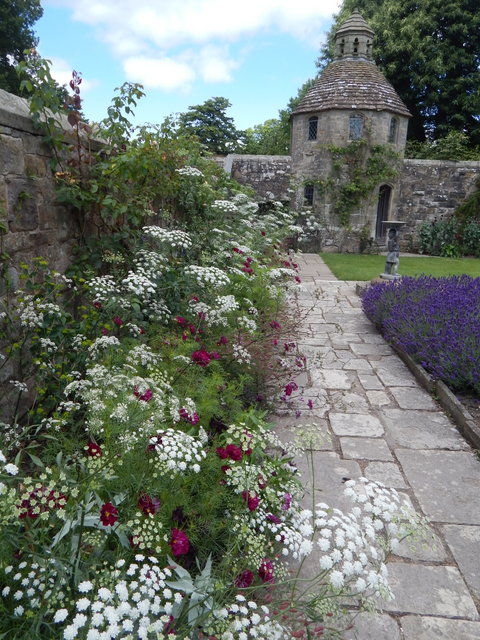
In the same garden a yew hedge cut in the shape of
Toblerone chocolate
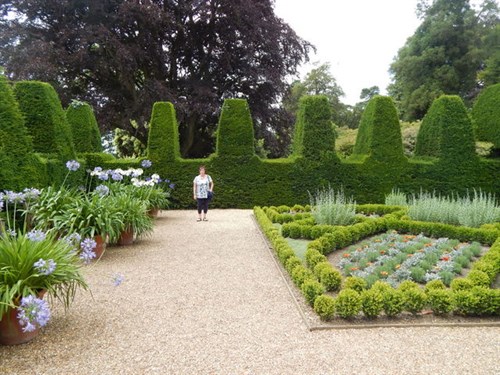
And a classic border in Gertrude's style but comprising
mostly annual plants, quite a tour de force of planting out and
maintenance

Another essential visit for a hosta nut like me with 250
cultivars, was to The Hanging Hosta Garden in Hampshire with over
1,500 hostas on display; most in pots large ones on the ground and
the smaller ones up the walls of the house and specially built
staging, all in the most superb condition. They were so tightly
packed that it was difficult to get round the garden but what a
tour de force


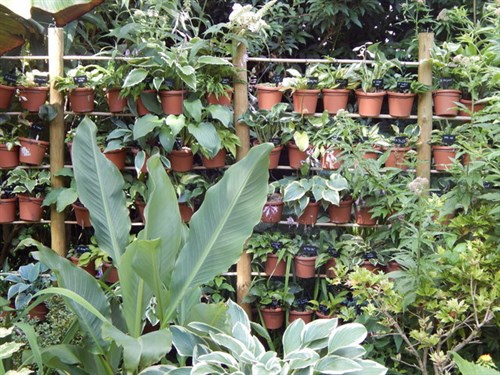
Our last garden visit in late July was to Waterperry
Gardens near Thame in Oxfordshire, a garden made famous 80 years
ago by Beatrice Havergill who ran a gardening school for ladies,
quite something in those days. When the gardens were sold the
current owners contiinued the tradition of horticultural excellence
and it has become one of our favourite gardens especially as there
is so much emphasis on perennial plants. In this pic is part of the
classic long herbaceous border in the Gertrude style with
magnificient contributions fron the silver eryngium "Miss Wilmotts
Ghost"

A significant part of the outer garden is given over to
nursery beds for herbaceous perennials, partly as trial beds,
partly to supply the main gardens with plants and partly for the
excellent plant sales nursery. It is not something you see very
often these days but for the plantsman instructive and
interesting

And then in the midst of all the large borders and
expanses of the wider garden, you come across this gentle,
secretive and contemplative enclosed space with, as its
centrepiece, a tasteful statue of a girl holding the luminous lamp
of wisdom to destroy the darkness of ignorance. Moving and
inspirational and the fitting end to the tour of Waterperry and to
conclude this News Item. Happy gardening.
